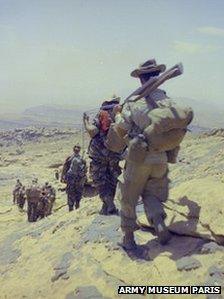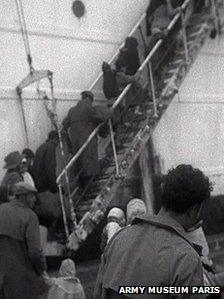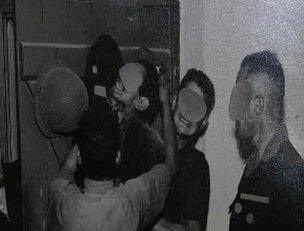France's war in Algeria explored in Paris exhibition
- Published

France was not defeated militarily in Algeria
On the 50th anniversary of Algerian independence, it might seem an odd choice to mount an exhibition marking 130 years of French colonial rule over the country.
But at the Army Museum at the Invalides in Paris, that is exactly what they have done.
Algeria 1830-1962 is a look back over France's long military presence there.
It starts with the arrival of an invading force at Sidi-Farruch in June 1830, and ends with the ignominious post-independence pull-out.
Visitors are treated to historic relics such as the ceremonial keys to the city of Algiers and the spurs of rebel leader AbdelKader.
But by far the greatest interest lies in the second part of the exhibition, which deals exclusively with the eight-year war of independence.
'Very sensitive questions'
Fortunately, this is no tub-thumping homage to "our-men-in-khaki" of the kind normally associated with military museums.
On the contrary, it is an honest attempt to understand a traumatic period of history which affected millions of people in sharply different ways.
"Our conception was to place the Algeria war in its long-term context," said Colonel Christophe Bertrand, the exhibition's curator.
"Obviously the emphasis is on the last eight years of France's presence, but a lot of what went on in the war can only be explained by what happened before.
"The story we tell is not one of brave paratroopers fighting nasty fellagha [bandits]. It is a story punctuated by phases of terrible violence, in which it is impossible to avoid some very sensitive questions."
The Algeria war began with a series of bomb attacks carried out by the National Liberation Front (FLN) in November 1954.
Since 1881 the country had been administered (unlike Morocco and Tunisia) as an integral part of France, with departments, communes and French place-names like Philippeville and Oran.
There were also around one million European settlers - not just French but also Italians, Spanish and Maltese - and a large indigenous community of Jews.
The war passed through various stages
helicopter-borne raids on the rural maquis [insurgents] of FLN's armed wing, the National Liberation Army (ALN)
sealing off the borders with Tunisia and Morocco
the so-called battle of Algiers against urban bomb-planters.
Images of war: Museum director Christian Baptiste explains what the exhibition is trying to achieve
Then came the Challe offensive of 1959 which effectively finished the ALN as a fighting force, and the hearts-and-minds campaign of the Constantine Plan which took army doctors and teachers out into the remote countryside.
For many historians, the irony is that, from a purely military point of view, the French army won.
But by the end of the 1950s, military victory had ceased to count.
Thousands dead
To Gen Charles de Gaulle - who took power in 1958 - it was obvious that the vast majority of Algerians supported national independence, while mainland French simply wanted the sorry story to end.
Talks with the FLN began as early as June 1960, prompting an angry backlash by the European settlers. There were riots in Algiers, and in 1961 part of the army there staged an unsuccessful military coup.

Many Harkis were met with indifference in France
Peace was signed at Evian in March 1962. Independence officially arrived on 5 July, though it is hard to pinpoint one day in what was in fact a long and often violent process.
One million settlers - the <italic>pieds-noirs</italic> - were uprooted and transported to France.
And a far worse fate lay in store for the tens of thousands of Algerians who had fought on the side of France. Some 30,000 <italic>harkis</italic> - and possibly many more - were massacred by the new Algerian authorities.
Lucky Algerian loyalists made it to France, though once there the indifference towards them shown by de Gaulle's government was a bewildering humiliation.
Today arguments rage over casualty figures for the war, but here are the numbers offered in a recent book by British historian Martin Evans, <link> <caption>Algeria - France's Undeclared War</caption> <url href="http://books.google.co.uk/books?id=3efpuozCiWYC&printsec=frontcover&source=gbs_ge_summary_r&cad=0#v=onepage&q&f=false" platform="highweb"/> </link>
Algerian fighters killed by French army: 140,000
Algerian civilians killed in French military operations: 60,000
Algerians killed by FLN: 37,000
Harkis killed at end of war: 30,000 (though some say 150,000)
French troops killed in action: 15,500
Settlers killed in FLN terrorism: 2,800
Victims (mainly Algerian) of settler terrorism in 1962: 1,700
All this is told in the exhibition, which draws on the army's own extensive film archives as well as photographs, uniforms, weapons and captured FLN documents.
'A disaster'

Photos of torture are on display at the exhibition
There is no hiding the FLN's use of terrorism and murder to force Algerians to drop their allegiance to the French.
But nor does the museum avoid the vexed issue of France's own use of torture, which is now known to have been routine.
Previously unpublished photographs show a man trussed up and slung beneath a wooden bar being beaten on the soles of his feet. In another, French officers grip a prisoner by the throat.
"Torture was one of the subjects which we could not just sweep under the carpet," said Col Bertrand.
"If we had, we would have completely lost our credibility."
Testament to the exhibition's success is that it is drawing in visitors of all backgrounds. Not all are happy, but they are certainly fascinated.
One <italic>pied-noir</italic>, now in his 80s, was angry at the portrayal of the war: "Why rake it all up again? It was a disaster, and now look at the mess the Algerian government has made of the country."
There are also many young Algerians, keen to see a version of their history outside their official textbooks, and French army veterans, from among 1.4 million conscripts who saw service in the war.
"There is no one truth about the Algeria war," said the museum's director Gen Christian Baptiste.
"There are many truths, and we have done our best to reflect all of them.
"The difficulty is that even after 50 years the suffering is still very raw. In many cases, the pain has been handed down from one generation to the next."
'Condemned to co-exist'
The past does indeed still cast a shadow over France's relationship with Algeria. Though the two countries are bound together by a web of human and economic ties, somehow the suspicion never disappears.
In recent years an attempt to draw up a Treaty of Friendship has come to nothing, largely because of Algeria's insistence that France first commit some act of official contrition.
But such an act is most unlikely to emerge.
"Acts of repentance for specific events are one thing but a general statement of repentance is meaningless," said historian Maurice Vaisse.
"Algeria was part of the global historical phenomenon of colonialism. Of course France profited greatly from it and there were great injustices, but by the time France left, Algeria was a developed country with elements of a modern economy.
"Many terrible things happened, but they were also committed on the Algerian side."
For historian Benjamin Stora, France and Algeria are "condemned to co-exist".
"But it is true that the question of memory is a problem," he adds.
"They say that memory divides. Only history heals. That is why it is the task of historians and politicians to tell the full story - from all sides."
The Army Museum's exhibition is part of that process.
- Published10 June 2011
- Published21 May 2010